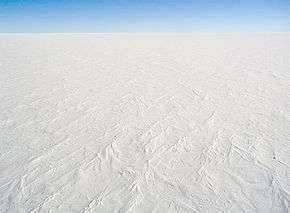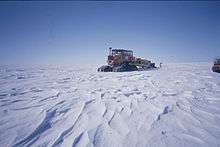Antarctic Plateau


The Antarctic Plateau, or Polar Plateau or Haakon VII Plateau, is a large area of East Antarctica which extends over a diameter of about 1,000 kilometres (620 mi), and includes the region of the geographic South Pole and the Amundsen–Scott South Pole Station. This huge continental plateau is at an average elevation of about 3,000 metres (9,800 ft) high.
Exploration
This plateau was first sighted in 1903 during the Discovery Expedition to the Antarctic, which was led by Robert Falcon Scott. Ernest Shackleton became the first to cross parts of this plateau in 1909 during his Nimrod Expedition, which turned back in bad weather when it had reached a point just 97 nautical miles from the South Pole. Shackleton named this plateau the King Edward VII Plateau in honor of the King of the United Kingdom. In December 1911, while returning from the first journey to the South Pole, the Norwegian explorer Roald Amundsen decided to name this plateau the Haakon VII Plateau in honor of the newly elected King Haakon VII of Norway.
The Antarctic Plateau was first observed and photographed from the air in 1929 from a Ford Trimotor airplane carrying four men on the first flight to the South Pole and back to the seacoast. The chief pilot of this flight was Bernt Balchen, a native of Norway, and the navigator and chief organizer of this expedition was Richard E. Byrd of Virginia, an officer in the U.S. Navy. The other two members of its crew were the co-pilot and the photographer.
Climate
The high elevations of the Antarctic or Polar Plateau, combined with its high latitudes, and its extremely long, sunless winters, mean that the temperatures here are the lowest in the world in most years, compare with central Siberia in the Northern Hemisphere.
Fauna
The nearly continuous frigid winds that blow across the Antarctic Plateau, especially in the long, dark wintertime, make the outdoor conditions there very inhospitable to life. Microbial abundance is low (<103 cells/ml of snowmelt). The microbial community is mainly composed of members of the Alphaproteobacteria class (e.g. Kiloniellaceae and Rhodobacteraceae), which is one of the most well-represented bacterial groups in marine habitats, Bacteroidetes (e.g. Cryomorphaceae and Flavobacteriaceae) and Cyanobacteria. Based on research, polar microorganisms should not only be considered as deposited airborne particles, but as an active component of the snowpack ecology of the lofty, icy Antarctic Plateau.[1]
No penguins live on the Antarctic Plateau, and no birds routinely fly over it. There are no land animals on Antarctic or Polar Plateau, except for nematodes, springtails, mites, midges, human beings and their laboratory animals.
See also
References
- ↑ Michaud L, Lo Giudice A, Mysara M, Monsieurs P, Raffa C, Leys N, et al. (2014) Snow Surface Microbiome on the High Antarctic Plateau (DOME C). PLoS ONE 9(8): e104505. doi:10.1371/journal.pone.0104505